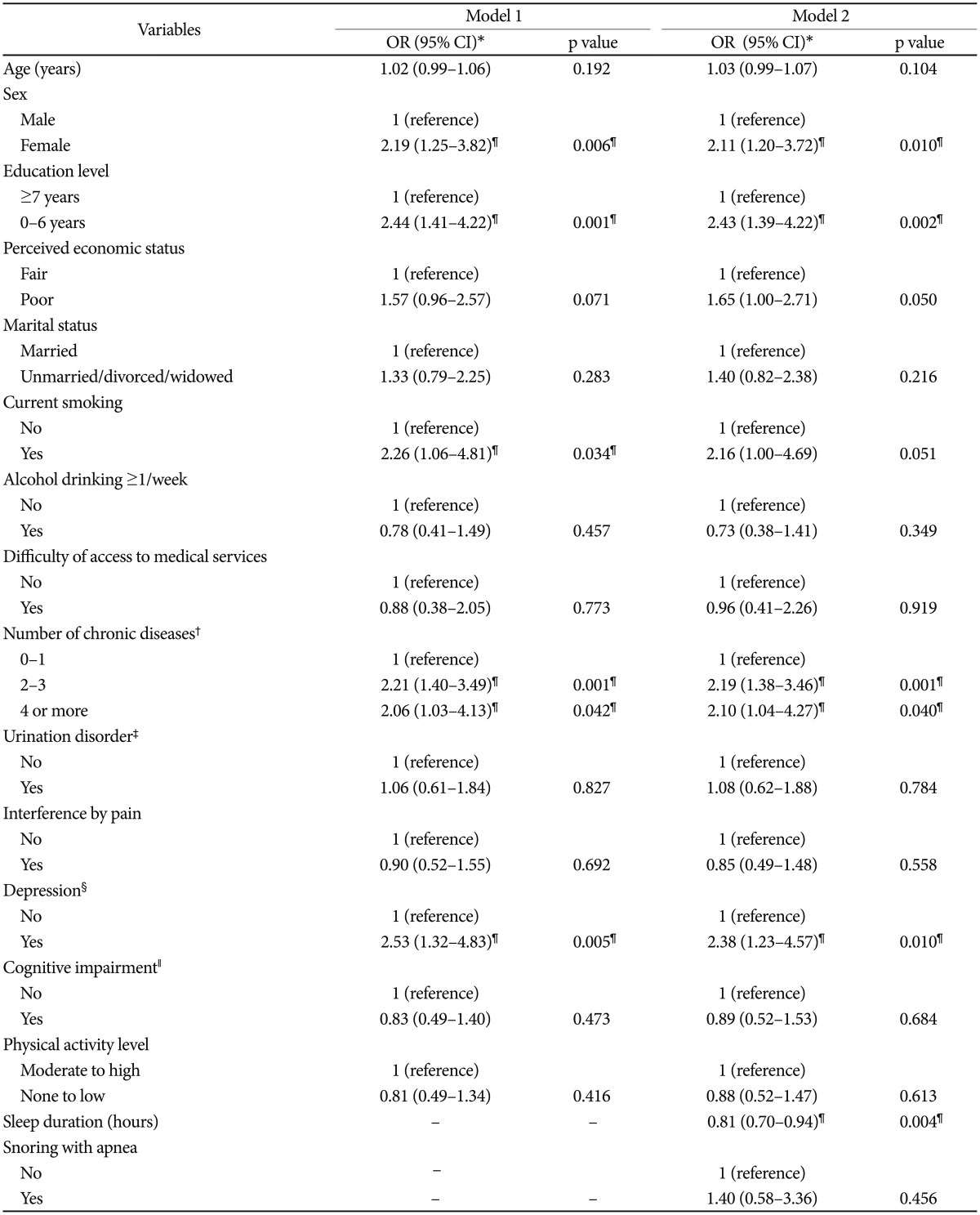2. Statistics Korea. Future Population Estimation: 2010-2060. Daejeon: Statistics Korea; 2011,January 4, 2016. Available at:
http://kostat.go.kr.
4. Ancoli-Israel S. Normal Human Sleep at Different Ages: Sleep in the Older Adult. In: Sleep Research Society, Editors. SRS Basics of Sleep Guide. Westchester, IL: Sleep Research Society; 2005, p. 21-26.
5. Ohayon MM. Epidemiology of insomnia: what we know and what we still need to learn. Sleep Med Rev 2002;6:97-111. PMID:
12531146.


7. Mallon L, Broman JE, Hetta J. Relationship between insomnia, depression, and mortality: a 12-year follow-up of older adults in the community. Int Psychogeriatr 2000;12:295-306. PMID:
11081951.


8. Stone KL, Blackwell TL, Ancoli-Israel S, Cauley JA, Redline S, Marshall LM, et al. Sleep disturbances and risk of falls in older community-dwelling men: the outcomes of Sleep Disorders in Older Men (MrOS Sleep) Study. J Am Geriatr Soc 2014;62:299-305. PMID:
24428306.



9. Lee M, Choh A, Demerath E, Knutson K, Duren D, Sherwood R, et al. Sleep disturbance in relation to health-related quality of life in adults: the Fels Longitudinal Study. J Nutr Health Aging 2009;13:576-583. PMID:
19536428.



10. Carroll JE, Seeman TE, Olmstead R, Melendez G, Sadakane R, Bootzin R, et al. Improved sleep quality in older adults with insomnia reduces biomarkers of disease risk: pilot results from a randomized controlled comparative efficacy trial. Psychoneuroendocrinology 2015;55:184-192. PMID:
25770704.



11. Yang CK, Yoo SY, Joo YH, Hahn HM. Sleep habits and sleep disorders among the elderly between 65-84 years who are living in a part of Pusan. Sleep Med Psychophysiol 1997;4:66-76.
12. Yoon JS, Shin IS, Kim JM, Kang SA, Ha HY, Park IS, et al. Sleep patterns and problems of the korean elderly in urban and rural areas. Korean J Sleep Med 1999;1:42-49.
13. Hong JP, Ahn JH, Yun YK, Park JI, Lee SY, Hahm BJ, et al. Sleep habits and insomnia-associated factors in the urban elderly: demographic, health and psychobehavioral correlates. J Korean Neuropsychiatr Assoc 2000;39:1111-1121.
15. Kwon SM, Seo JS, Yang SK, Choi JY, Yim HW, Jo SJ, et al. A field study of the conditions of the elderly in rural community: the correlation between of sleep quality and quality of life. J Korean Neuropsychiatr Assoc 2012;51:119-126.

16. Yang HC, Suh S, Kim H, Cho ER, Lee SK, Shin C. Testing bidirectional relationships between marital quality and sleep disturbances: a 4-year follow-up study in a Korean cohort. J Psychosom Res 2013;74:401-406. PMID:
23597327.


17. Chang KJ, Son SJ, Lee Y, Back JH, Lee KS, Lee SJ, et al. Perceived sleep quality is associated with depression in a Korean elderly population. Arch Gerontol Geriatr 2014;59:468-473. PMID:
24852666.


18. Carvalho FG, Hidalgo MP, Levandovski R. Differences in circadian patterns between rural and urban populations: an epidemiological study in countryside. Chronobiol Int 2014;31:442-449. PMID:
24397277.


19. Cho HJ. Equity in health care: current situation in South Korea. J Korean Med Assoc 2013;56:184-194.

21. Maruish ME, Turner-Bowker DM. A Guide to the Development of Certified Modes of Short Form Survey Administration. Lincoln, RI: QualityMetric Incorporated; 2009.
22. Bae JN, Cho MJ. Development of the Korean version of the Geriatric Depression Scale and its short form among elderly psychiatric patients. J Psychosom Res 2004;57:297-305. PMID:
15507257.


25. Lee SW, Youm Y, Kim CO, Lee WJ, Choi W, Chu SH, et al. Association between skeletal muscle mass and radial augmentation index in an elderly Korean population. Arch Gerontol Geriatr 2014;59:49-55. PMID:
24836439.


26. Lee SW, Youm Y, Lee WJ, Choi W, Chu SH, Park YR, et al. Appendicular skeletal muscle mass and insulin resistance in an elderly Korean population: the Korean social life, health and ageing project-health examination cohort. Diabetes Metab J 2015;39:37-45. PMID:
25729711.



27. Chu SH, Baek JW, Kim ES, Stefani KM, Lee WJ, Park YR, et al. Gender differences in hypertension control among older Korean adults: Korean social life, health, and ageing project. J Prev Med Public Health 2015;48:38-47. PMID:
25652709.



29. Li J, Yao YS, Dong Q, Dong YH, Liu JJ, Yang LS, et al. Characterization and factors associated with sleep quality among rural elderly in China. Arch Gerontol Geriatr 2013;56:237-243. PMID:
22906471.


30. Weyerer S, Dilling H. Prevalence and treatment of insomnia in the community: results from the Upper Bavarian Field Study. Sleep 1991;14:392-398. PMID:
1759091.

31. Foley DJ, Monjan AA, Brown SL, Simonsick EM. Sleep complaints among elderly persons: an epidemiologic study of three communities. Sleep 1995;18:425-432. PMID:
7481413.


32. Smagula SF, Stone KL, Fabio A, Cauley JA. Risk factors for sleep disturbances in older adults: evidence from prospective studies. Sleep Med Rev 2016;25:21-30. PMID:
26140867.


33. Chang PP, Ford DE, Mead LA, Cooper-Patrick L, Klag MJ. Insomnia in young men and subsequent depression. The Johns Hopkins Precursors Study. Am J Epidemiol 1997;146:105-114. PMID:
9230772.



34. Katz DA, McHorney CA. Clinical correlates of insomnia in patients with chronic illness. Arch Intern Med 1998;158:1099-1107. PMID:
9605781.


35. Cho MJ, Nam JJ, Suh GH. Prevalence of symptoms of depression in a nationwide sample of Korean adults. Psychiatry Res 1998;81:341-352. PMID:
9925185.


38. Cutler DM, Lleras-Muney A. Education and Health: Evaluating Theories and Evidence. National Poverty Center Working Paper Series. Cambridge, MA: National Bureau of Economic Research; 2006.
39. Su TP, Huang SR, Chou P. Prevalence and risk factors of insomnia in community-dwelling Chinese elderly: a Taiwanese urban area survey. Aust N Z J Psychiatry 2004;38:706-713. PMID:
15324335.


40. Ito Y, Tamakoshi A, Yamaki K, Wakai K, Kawamura T, Takagi K, et al. Sleep disturbance and its correlates among elderly Japanese. Arch Gerontol Geriatr 2000;30:85-100. PMID:
15374035.












